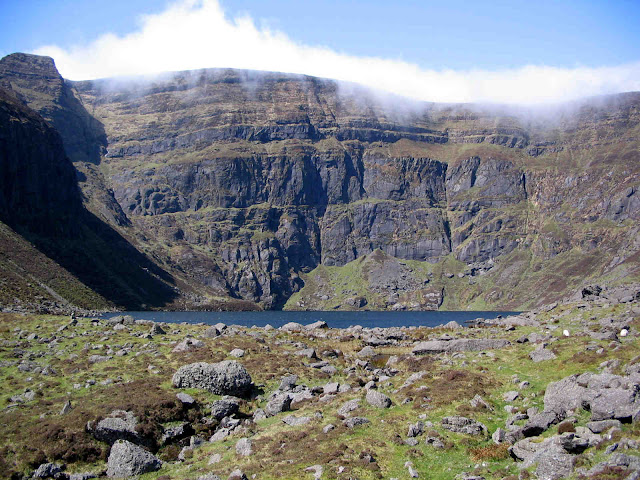Crotty the Robber
Rapparees
The word “ropaire” in Irish has come to mean robber but in the late 17th century the term “ropairí” (the verb “ropaim” means I tear) referred to short pike wielding guerrilla fighters who fought on the side of the Jacobites against the Williamites and who continued to harass the forces of the law well into the 18th century. They came to be known as rapparees and loosely they equated to the highwaymen of English tradition of that period. The rapparee was often regarded as a type of social bandit, officially an outlaw but not seen as a criminal by his own community. In fact, many rapparees were admired by the Irish peasants. They were seen as brave opponents of the oppressive colonial system. They were often lauded in verse, think of the song “Brennan on the moor”, praising the deeds of Willie Brennan around the Kilworth mountains. They would often show up at fairs and funerals, sometimes sharing their spoils with members of their community. Were they as black, as portrayed by the British, or as white, as portrayed by the Irish? They were probably somewhere in between - some were undoubtedly rebelling against social injustice while others were merely opportunistic criminals.Who was William Crotty?
Was he a legendary character or a real life Comeragh rapparee? The evidence of history and tradition overwhelmingly points to the latter. In 1915 a local historian from Tramore, Matthew Butler, visited the Office of Public Records in the Four Courts in Dublin and copied down the court case details of March 1742 just seven years before most of the records were destroyed in the fire of 1922. These notes on Waterford history can be found in the National Library.
In their book “Waterford, Heroes, Poets and Villains”, Seán and Sheila Murphy regale the reader with many “tall tales and true” about Crotty. He was born about 1712 in Russellstown, outside Clonmel. Legend has it that he formed his gang of up to thirty men at about eighteen years of age and spent the next twelve robbing and looting. Despite his reputation Crotty was popular with the ordinary people, often turning up at fairs and patterns. Was he a murderer? The weight of evidence would suggest yes. During the court proceedings a couple of witnesses swore that Crotty broke into the house of George Williams of Clonea in February 1742 and shot him dead. It would seem that one of Crotty`s chief lieutenants, David Norris, betrayed him and he was captured in February 1742. After a quick trial he and a number of his gang were hanged in March 1742. Afterwards Crotty`s head was placed on a spike outside Ballybricken Jail in Waterford.
Crotty`s Coum, Lake and Rock
Crotty`s is a very impressive coum with vertical cliffs along the backwall about 250 metres high. The coum is fronted by a 30 metres high impounding moraine and has a small dry inner hollow perched up under the backwall. Crotty`s was formerly known as “Com an Gháire” which means the hollow of the laugh or shout, probably because of the echo effect noticeable high up in the coum. This was reputedly where Crotty hid when the heat was on. Legend has it that he holed up in a cave near the lake. The cave is still there today but it is more of a long narrow fissure, created by jointing, with a small hole at the top. It is difficult to believe that anyone could have stayed here for any length of time. High above the lake is “Stolla Chrotaigh”, Crotty`s Stool or Rock (sometimes locally called the “Ass`s Ears”). Crotty`s Rock consists of two giant columns of rock created by severe vertical jointing. These twin pinnacles were supposedly Crotty`s lookout. It was from here also that Crotty`s wife, Mary, reputedly jumped to her death soon after his execution.Crotty`s Treasure and Crotty`s Ghost
Local folklore tells us that as Crotty mounted the scaffold he spoke to the crowd in Irish and revealed the location of his booty. One version, according to Seán and Sheila Murphy, states that Crotty announced “there is a bush in Curraheen and a bush in Curlandy and a bush in Ross and in between two of these bushes is located a stone with a horseshoe mark and beneath this stone is the boot of gold”. Has anyone ever found the treasure? Ah there`s a question! What about “the dark stranger”, as Crotty`s ghost is called? He reputedly haunts the Comeraghs, appearing out of the mist, sometimes around the mountain roads of Crough and Curraheen, sometimes by the shores of the loughs. Has anyone seen him lately? As might be expected, a number of songs and laments have been written about Crotty, one of them by his wife. The first verse of this goes:“William Crotty I often tould you,
That David Norris would come round you,
In your bed, when you lay sleeping,
And leave me here in sorrow weeping,
Ochón is ochón”
That David Norris would come round you,
In your bed, when you lay sleeping,
And leave me here in sorrow weeping,
Ochón is ochón”





Comments
Post a Comment